David Meerman Scott's Blog, page 78
December 27, 2012
The Icarus Deception: How high will you fly?
 A decade ago I left a nice, safe corporate career to find my art and discover my true self. It was scary. I didn't know where the journey would lead nor if I could make a living by my own wits. Seth Godin's The Icarus Deception: How High Will You Fly? is an ambitious work that challenges you to do the same. It's for anyone who is living life as a cog in the machine and who dreams of breaking free, making art, and creating something meaningful. You don't have to leave your current job to make art, but like me, you might be forced to.
A decade ago I left a nice, safe corporate career to find my art and discover my true self. It was scary. I didn't know where the journey would lead nor if I could make a living by my own wits. Seth Godin's The Icarus Deception: How High Will You Fly? is an ambitious work that challenges you to do the same. It's for anyone who is living life as a cog in the machine and who dreams of breaking free, making art, and creating something meaningful. You don't have to leave your current job to make art, but like me, you might be forced to.
Seth launched the book via Kickstarter and because I am a backer, I got an early copy. The book releases to the public on December 31.
Part of the reason I chose to start my own business was Seth's 1999 book Permission Marketing had recently been released and for me, the book clearly articulated the online marketing revolution that we were on the cusp of. I just had to take advantage of those ideas but that marketing radicalism just didn't fly with the corporate status quo. There are no boxes in the org chart for a "ruckus maker".
For me, creating art meant starting something new. But you can create art within an existing structure too. It's the doctor who chooses to communicate with patients on Skype video when they have questions even though the medical establishment looks down on such personal care. It's the customer service rep who brings his colleagues together every Friday afternoon to figure out ways to do their jobs better. It's anyone who picks herself to do something important rather than waiting for an authority figure to give authorization to proceed.
I read each and every Seth book the moment they come out. And if you take a look at my Amazon reviews, you'll see that I talk about many of them. Yes, I'm a fanboy. But that's because Seth has an uncanny ability to generate ideas that prompt me to think about what I'm doing in new ways.
The Icarus Deception will likely make you uncomfortable. The ideas push you to evaluate the nature of your work and your life. Hopefully, like me, Seth's thoughts are a catalyst for you to stop simply doing what the bosses say and live as an artist: to try the untested, to challenge accepted wisdom, to build something new, to travel without a roadmap, to make a difference. I only wish this book had been available ten years ago when I was ready to fly.
December 26, 2012
Advice on getting media coverage for your business
Last month I was a panelist in a session called Get Famous Fast: Helping entrepreneurs win at media relations at the MassTLC Innovation 2012 Unconference.
Our ringmaster Scott Kirsner just posted the full audio from the session on his Boston Globe Innovation Economy blog. If you find yourself with a little time during this quiet holiday period, the audio from this session contains 35 valuable nuggets of wisdom from the panel.
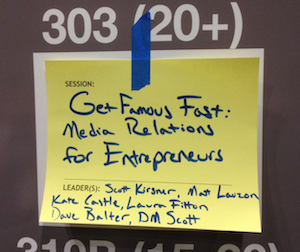 As Scott says: "Our goal was to capture advice from everyone in the room about how entrepreneurs can build relationships with reporters / bloggers / TV producers, and how to successfully pitch story ideas to them."
As Scott says: "Our goal was to capture advice from everyone in the room about how entrepreneurs can build relationships with reporters / bloggers / TV producers, and how to successfully pitch story ideas to them."
Joining me as panelists were Kate Castle VP Marketing at Flybridge Capital Partners; Dave Balter founder and CEO of BzzAgent; Laura Fitton, HubSpot's Inbound Marketing Evangelist; and Matt Lauzon who co-founded Gemvara.
I previously blogged about the panel here, but at that time did not have the audio.
Photo courtesy of Scott Kirsner.
December 19, 2012
Inbound PR and a free Newsjacking book excerpt
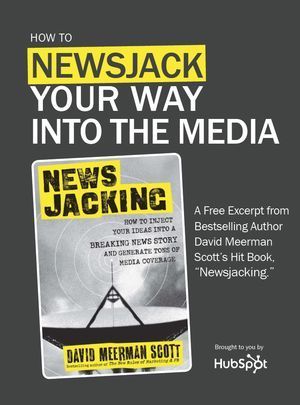 Getting positive attention for your business via mainstream media is great! That's why organizations spend so much money on PR agencies and staffers.
Getting positive attention for your business via mainstream media is great! That's why organizations spend so much money on PR agencies and staffers.
But the old "outbound" approach - sending a press release or PR pitch to hundreds of journalists via email doesn't work so well in a world of instant communications.
Media outlets work at rapid pace, constantly striving to publish the most relevant and newsworthy content. The new way to reach members of the media uses "inbound" PR - creating content that journalists are looking for as they write breaking news stories.
Newsjacking
Regular readers of my blog know I call this approach Newsjacking which is the subject of my most recent book.
I've teamed up with HubSpot (I'm on the HubSpot advisory board) to offer a free excerpt of Newsjacking.
I'm also holding a Twitter chat about Newsjacking Thursday December 20 at 2:00 pm ET. You can join me by using the hashtag for the chat - #inboundchat.
If you haven't read my Newsjacking book, here is an opportunity to download a free excerpt. Learn how to transform your PR from outbound to inbound.
December 17, 2012
Market competition and your business
 There are many ways to compete in a marketplace. You already know them.
There are many ways to compete in a marketplace. You already know them.
But are you really conscious of your place in the market?
How do your customers define you? How do you define yourself? What makes you special? You’ve got to know what you do better than the other guys and deliver even more of that.
You cannot do everything so letting the other guy offer the cheapest price or have the slickest product is just fine of you’ve, say, got the very best service.
Produce markets in Morocco
This past long weekend I was in Morocco and became fascinated with the local produce markets. I went to several in Marrakech and a country market in Asni at the foothills of the Atlas Mountains that's held once a week.
The produce sellers offer the same basic items and sell in a similar way. But lingering and observing, I noticed ways the proprietors differentiated.
Location - Some sellers got prime position near the entrance to the Medina (ancient walled city) in Marrakech. A similar strategy was to stake out a position near the entrance to the marketplace in Asni. I'm not sure if these spots go to the first to arrive in the morning or if somebody is paid, but there are definitely good and bad locations.
 Product – It was orange season in Morocco. The oranges were at nearly every stall and were delicious and cheap. I ate so many I thought my skin would turn orange. If everyone basically sells the same thing, how do you differentiate product? Then I noticed that some sellers had leaves still on the oranges they were selling. This indicated that the fruit had just been picked because the leaves quickly wilt.
Product – It was orange season in Morocco. The oranges were at nearly every stall and were delicious and cheap. I ate so many I thought my skin would turn orange. If everyone basically sells the same thing, how do you differentiate product? Then I noticed that some sellers had leaves still on the oranges they were selling. This indicated that the fruit had just been picked because the leaves quickly wilt.
Comfort – A few stalls had coverings where people could shop outside of the hot sun. While this might be comfortable to haggle over some fruit and veggies, it was very bright and the direct sun enhanced the look of the products so…
 Display – When artfully arranged in direct sunlight, the items just looked tastier.
Display – When artfully arranged in direct sunlight, the items just looked tastier.
Service – Being friendly, offering a free sample, tossing in a few extra, packaging in two bags instead of one to make it easy to carry are indications of good customer service, another way to differentiate.
Price – When everyone sells the same thing, there’s a low cost provider. But with margins thin, that’s a tough position to be in.
Advertising – Some of the sellers called out information about their fruit and vegetables.
Sales – Some sellers tried to hustle people into their stalls. But usually the hard sell doesn't work.
Kindness – Some sellers just smiled and caught your eye.
There are probably other ways the produce sellers differentiated that I didn’t notice. Certainly as I don’t speak the local Berber language, there was a lot happening that I didn’t catch.
How do you compete?
We all compete for business in a crowded marketplace of ideas, services, and products. There are many different ways to compete and differentiate your offerings. Copying the other guys is a tough way to succeed.
You've got to know how you're different than the other guys.
You've got to stake a claim as being the best at something.
Photos by David Meerman Scott taken with an iPhone 4S
December 11, 2012
What converging mainstream and social media means for marketing and PR
 Too many people are still hung up with outdated artificial demarcations between "mainstream media" and "social media", arguing that one is more legitimate. This leads to flawed marketing and PR strategic decisions.
Too many people are still hung up with outdated artificial demarcations between "mainstream media" and "social media", arguing that one is more legitimate. This leads to flawed marketing and PR strategic decisions.
This is especially true of many (but not all) public relations agencies whose reps do their clients a disservice by focusing on one form of media over another.
Nonsense. The distinctions have nearly disappeared. You've got to eliminate your prejudice.
Whenever this subject pops up, I'm prompted to ask some questions:
- What is a blog?
- What is an online news site like Huffington Post?
- What is it when a print newspaper like the New York Times or a television network like the BBC publishes an online news site?
- What is it when readers can post comments to on an online story from a magazine?
- What about when a reporter for the BBC maintains a blog?
- What are the Twitter feeds of New York Times reporters?
Guess what? It's all just real time media!
The Huffington Post is a technically a blog. It is written on the Blogger platform so there is no difference technically when I write for the Huffington Post or when I write on Web Ink Now, my personal blog.
The Huffington Post is a blog, but is one of the most important news sites on the Web with a recent Alexa ranking as I write this of 77, making it in the top 100 of all sites of any kind in the world.
The Huffington Post is a blog, but won the Pulitzer Prize in the category of national reporting for senior military correspondent David Wood's 10-part series about wounded veterans, Beyond the Battlefield.
The BBC is mainstream media, but readers can comment on stories (and thousands do).
The New Yorker is a magazine, but people can share links to stories within the site using widgets for Facebook, Twitter, LinkedIn, Pinterest, Google+, and Tumblr.
What the blurring of mainstream media and social media means for your business
When your buyers search Google or another search engine for information related to your business, they don't really care if the top results come from a "news site" like the BBC, a "blog" like the Huffington Post, or your own content rich Web site. So you need to eliminate the bias.
When buyers ask a question on social media they are happy when someone sends a valuable link to information on the web. They don't scrutinize what’s recommended to them and dismiss the blog content and only read the remainder. They're happy for something that educates and entertains.
The best marketing and PR strategies must include creating your own content, including text, video, and images. It should also include strategies for getting noticed by important voices so they write about you, which comes back to the content you create.
photo credit: DanAllison via photopin cc
December 7, 2012
SEC action against Netflix CEO over Facebook post is completely wrong
 The US Securities and Exchange Commission is considering taking action against Netflix and its CEO Reed Hastings because of a Facebook post.
The US Securities and Exchange Commission is considering taking action against Netflix and its CEO Reed Hastings because of a Facebook post.
The agency says that the update to Hastings' 200,000+ subscribers where he said "members had enjoyed over 1 billion hours in June" violated the SEC Regulation Fair Disclosure (Reg FD) rule.
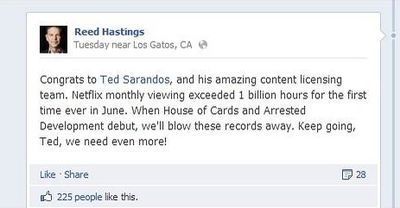 The SEC is charged with making securities trading fair and since Netflix is a publicly traded company, the SEC has oversight. RegFD is the SEC rule that says when a company discloses something of material importance (something that might affect the stock price) that the information needs to be sent to everybody at once.
The SEC is charged with making securities trading fair and since Netflix is a publicly traded company, the SEC has oversight. RegFD is the SEC rule that says when a company discloses something of material importance (something that might affect the stock price) that the information needs to be sent to everybody at once.
According to the SEC: "Regulation FD provides that when an issuer discloses material nonpublic information to certain individuals or entities—generally, securities market professionals, such as stock analysts, or holders of the issuer's securities who may well trade on the basis of the information—the issuer must make public disclosure of that information."
The SEC is completely wrong
The issue is not with Netflix. It is with the dinosaurs at the SEC. This is not a stock story. It is a real-time communications story.
 The post that Hastings sent out was to his Facebook PUBLIC followers list which currently numbers 245,000 people. Anybody can subscribe to the list and anybody can access the content at any time without subscribing. I do not subscribe and it took me less than five seconds to access it – go to Facebook and type 'Reed Hastings' in the search bar. Bingo.
The post that Hastings sent out was to his Facebook PUBLIC followers list which currently numbers 245,000 people. Anybody can subscribe to the list and anybody can access the content at any time without subscribing. I do not subscribe and it took me less than five seconds to access it – go to Facebook and type 'Reed Hastings' in the search bar. Bingo.
Any journalist or securities analyst who has any brains at all would be following what Hastings is saying on his public Facebook posts.
Here's the important point -- by posting to Facebook, Hastings is getting the news out fairly to anyone who wants to see it.
The SEC considers press releases to be the acceptable way to comply with RegFD.
Press releases are fine, but in 2012 saying that only press releases qualify for fair disclosure is like saying the only way to watch movies is in a theater. In fact, when I looked for press releases from Netflix it took me much longer than five seconds to find the relevant pages.
Time to re-think fair disclosure
There is no question, based on my extensive previous experiences - 1) working in the real-time news business for a decade; 2) as head of corporate communications for two public companies and 3) as VP marketing for Fair Disclosure Financial Network - that the SEC is wrong.
The SEC needs to develop new rules on what disclosure is in our world of instant communications.
If anyone from the SEC reads this, I'd be happy to come down to Washington and educate you on the new tools of real-time communications. But since this is not a press release, I doubt we'll hear from the lawyers down in D.C.
December 6, 2012
Not Another Junky Blog
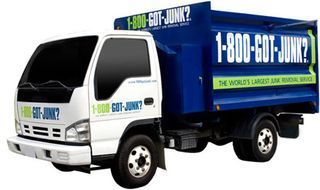 Tania Venn, director of PR at 1-800-GOT-JUNK?, the largest full-service professional junk removal company in the world, oversees a team that creates content with a focus to reach customers who may not think that they need a junk removal service.
Tania Venn, director of PR at 1-800-GOT-JUNK?, the largest full-service professional junk removal company in the world, oversees a team that creates content with a focus to reach customers who may not think that they need a junk removal service.
“Once they hear about what junk removal could do for them and how it could impact their lives, they become interested in our service,” Tania says.
Tania and her colleagues focus on what information would be valuable for buyers as they create content for the 1-800-GOT-JUNK? Not Another Junky Blog and then use their Facebook page and Twitter feed @1800GOTJUNK to let their followers know of new posts.
Making junk interesting
I hear all the time from marketers who tell me something like "My business is boring. Nobody cares about what we do so how can I create content?"
Tania's example shows any market or company can be made to be interesting. We're talking about junk removal here, people!
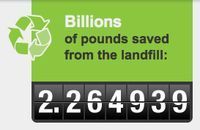 "We think about what’s relevant," she says. "That could be tips and suggestions for people on getting their space back. It could be about decluttering and how to do a garage sale. We also focus on environmental sustainability, what happens to the stuff we haul away and creative ways to reuse junk." Right on the homepage there is a counter showing the number of pounds 1-800-GOT-JUNK? has saved from landfills. As of this writing, the ticker reads 2.264937 billion pounds.
"We think about what’s relevant," she says. "That could be tips and suggestions for people on getting their space back. It could be about decluttering and how to do a garage sale. We also focus on environmental sustainability, what happens to the stuff we haul away and creative ways to reuse junk." Right on the homepage there is a counter showing the number of pounds 1-800-GOT-JUNK? has saved from landfills. As of this writing, the ticker reads 2.264937 billion pounds.
They also create content about what's timely, either because it is in the news or tied with the time of year. "With the holidays coming up we'll post about making space to have your in-laws over and making room for new things you might get as gifts," Tania says. "And with New Years, everyone has resolutions. We know that the top ten New Year's resolutions includes 'getting organized' and 'simplifying'. We also look at what's trending. For example, there is a trend called trashion, when people make fashion out of trash, so we'll write about that."
Writing for buyers
Unlike when a blog is written from an egotistical perspective and turns into a bunch of advertising messages, Not Another Junky Blog, because it is written for buyers, focuses on real problems that people have with junk in the home.
"We know there’s an emotional component to getting rid of the stuff that you have," Tania says. "Our customers have an emotional release and an amazing magical feeling of 'that crap is not there anymore' when their junk is taken away. They don't realize until it's gone how good it feels. We hear it time and time and time again from our customers. So we build that into our blog because it answers what customers are looking for." The 1-800-GOT-JUNK? business is a franchise model, so the content they create also appeals to franchisees who learn about clever ways to market in their local area.
When you focus on buyers' problems as you create content, frequently you'll write about something that doesn't have anything to do with what your organization actually does. This is true at 1-800-GOT-JUNK?.
"We might talk about how to set up your own garage sale," Tania says. "That wouldn't get us business necessarily, but we’ve got the experience and we can share that with people. We know that readers may not be able to afford our service right now, but some day they will be able to. They'll have learned something from us that can help them out, something that can help them get rid of some of their junk, but they can do it themselves."
Measuring success
It's not just the billions of pounds of junk that the company saves from landfills that's measured. Tania knows that the content published in Not Another Junky Blog and shared on Facebook and Twitter is working because she uses analytics to measure content success too.
"I look at how many people view our blog on a daily basis and a weekly basis," she says, also paying attention to any content that becomes particularly popular with readers. "We've learned that we need to create content in order to be recognized on the web. It's a way of engaging with customers. It's a great way to get information directly to who you want to reach rather than going through the media."
Hey, if Tania can make junk interesting, there's no excuse for you not making your company interesting!
December 4, 2012
The second most important communication revolution in history
I’d like to step way back and look at the big picture of where we are today. To use a cliché, this isn't a "30,000-foot view". Rather it's more like the view from the moon.
Johannes Gutenberg invention of mechanical movable type printing in about 1439 was the most important communications breakthrough in history. It meant books could be mass produced, rather than painstakingly copied by hand. It meant ordinary people could refer to things in books, like laws, that used to have to be committed to memory.
The printing press created the first communications revolution by freeing people from memorizing information which allowed them to use brainpower to create things instead. At the same time, this first communications revolution (which took many decades) meant that large numbers of people became literate, raising living standards along the way.
The second most important communication revolution in history
556 years later, in 1995, the second most important communications revolution took off. I choose 1995 because it was the year Netscape went public on the success of Netscape Navigator the first popular product to allow people easy Internet connections and Web browsing.
I talk about it in this short clip. My friend Chris Brogan pointed out that I ended the clip abruptly. True. The clip was taken from my new speaking highlight reel. The entire video is about 8 minutes and is here if you want to check it out: Marketing and Leadership Speaker David Meerman Scott.
We're fortunate to be living in this time in history. We're actually living through an important revolution.
I figure we're about half way through this second communications revolution. The first 17 years or so were fast paced and things changed very quickly. Adoption went from a few million people online to billions. But things are still changing, as many organizations aren't truly communicating in real-time yet.
You are what you publish
The next few decades will see continuation of the revolution. Are you a supporter of the revolution? Or do you support the old regime?
November 29, 2012
Full video of my Inbound 2012 keynote featuring Cyndi Lauper
 Several months ago I kicked off HubSpot's Inbound 2012 conference in Boston with a keynote titled "Inbound Now" detailing how to get found as people search for products and services on the Web and mobile devices like Androids and iPads. The video of the talk is now available.
Several months ago I kicked off HubSpot's Inbound 2012 conference in Boston with a keynote titled "Inbound Now" detailing how to get found as people search for products and services on the Web and mobile devices like Androids and iPads. The video of the talk is now available.
The presentation to 2,500+ entrepreneurs and marketing professionals focused on the 4 ways to create the information that search engines rank highly and that people share on social networks like Twitter, Facebook, and LinkedIn.
Featuring Q&A with and a live performance by Cyndi Lauper!
Being a live music geek, I played off the conference theme Inbound Rocks to use music examples - including the Grateful Dead, Amanda Palmer, the Avett Brothers, STS9, and Cyndi Lauper - throughout the talk and was thrilled to interview Cyndi live on stage.
Direct link to David Meerman Scott keynotes Inbound 2012 featuring Cyndi Lauper on Vimeo.
At about 7:45 is a one-minute video interview I did with Amanda Palmer. Amanda talks about how she engages with her fans on social networks. Amanda crowdsourced the funding of her latest album on Kickstarter in what is the most successful music funding effort in Kickstarter history.
At about 31:50 I go into the audience to show how the Grateful Dead engaged fans. I find out how many people are Grateful Dead fans and who in the audience has attended multiple Dead shows. This is to prove the "true fans come back for more & spend lots of money" idea. In 2,500-person audience, about 100 had seen the band live. About 10 had seen more than 50 shows. Three over 100 shows and the most was 173 times.
At about 40:30 I interview Cyndi Lauper live. We talk about how she stays relevant and engages with fans through social media. First thing out of Cyndi's mouth (after she compared our shirts): "I stopped listening to the record company."
And at 45:30 Cyndi and her band did a killer live performance of "Crossroads." Her band featured blues harmonica legend Charlie Musselwhite.
November 27, 2012
Google Plus emerging as a back door to top search results
 Google News results now prominently show results from Google Plus (Google+ or just G+). This presents an exciting opportunity for real-time marketers for newsjacking using Google+.
Google News results now prominently show results from Google Plus (Google+ or just G+). This presents an exciting opportunity for real-time marketers for newsjacking using Google+.
How Google+ has changed since launch
When Google+ first emerged in the summer of 2011, it looked to me like a direct competitor to Facebook. Not that the application actually looked like Facebook but that it played in the same market of social sharing and connecting friends. When I first wrote about G+ in my post I really wanted to hate Google Plus that's what my focus was.
Initially many people used G+ for business purposes in similar ways that they used other social networks. You first create a personal profile and then figure out if there is a clever way to use G+ for your business.
I've noticed a significant trail off in interest in G+ in the past year or so as people who didn't need a "better Facebook" stopped engaging on the G+ social network. That's been my personal experience too. I still post my new blog posts to G+ but I don't go in to see what others are doing nearly as often as I do on Facebook and Twitter.
Google Plus emerging as a cool back door to top search results
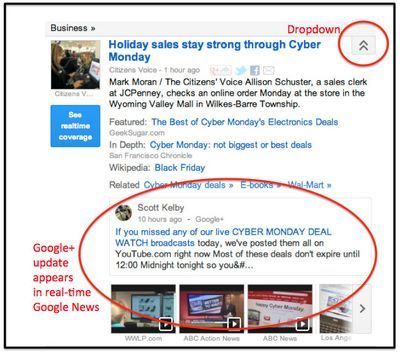 Now there's a way to use G+ for business that has real potential. If you go to Google News, you'll see a dropdown arrow button if you mouse over on the right of each headline. Clicking the arrows reveals more stories and those frequently include a G+ listing.
Now there's a way to use G+ for business that has real potential. If you go to Google News, you'll see a dropdown arrow button if you mouse over on the right of each headline. Clicking the arrows reveals more stories and those frequently include a G+ listing.
For example, in the business section story this morning talking about "Cyber Monday", the last item (with tons of real-estate) is a G+ update from Scott Kelby. I took a screen shot so you can see how it looked for me this morning.
How cool is that? A mere mortal can get into the front page of Google News just by making a real-time G+ update on a breaking news story.
Note that I do not know Scott and we are not connected on G+.
This has significant potential for marketers who want to inject their ideas into a breaking news story.
I’ll be experimenting with this in the coming weeks and months. Meanwhile, do let me know in a comment if you’ve had any newsjacking success with Google Plus.



